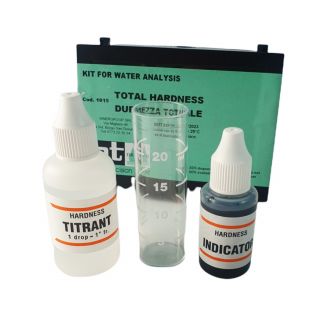-
Water Treatment
- Water Softeners
- Water Purifiers, Refrigerators, Carbonators
- Accessories and Components for Water Purifiers
-
Water Filters and Components
- Bayonet Water Filters
- Bayonet water filters mixed connection
- Brackets for Housings Containers
- Containers for Filters and Membranes
- Containers for Filters drop-in
- Filtering masses
- Filters and Descaling Systems
- Filters for Bottles
- Filters for Carafes
- Filters for On-Tap
- Filters for osmosis containers
- Keys for Housings Containers
- Line Water Filters
- Osmotic Membranes
- Refillable cartridges
- Sand filter filters for irrigation
- Water Filter Heads
- Water Filters Drop in
- Hydraulic fittings
- Taps and Columns for Water Purifiers
- Co2 Gas Cylinders and Pressure Reducers
- Manual and portable water gas
- Waste treatment
- Beer - Home / Pub
- Christmas Lights and Decorations
- Garden and Outdoors
- Entertainment and Leisure
- Original Gift Ideas and Gadgets
- OUTLET Warehouse
Titrant ANALYSIS KIT Total hardness kit - 1 ° F
TOTAL HARDNESS - Instructions for use
1. Repeatedly rinse the tube with the water to be tested by filling it up to the 5ml mark.
2. Add 1-2 drops of hardness indicator and shake. In the presence of hardness higher than 3 ppm CaCO3 the water turns red (in the absence of hardness the water turns pure blue. In the presence of traces of hardness. The water turns purple for about 1 ppm. gray for about 2 ppm and in dirty pink between 2 and 3 ppm CaCO3).
3. Add the titrant solution drop by drop, and shake after adding each drop. Count the drops needed to achieve the red to blue color change. Each drop consumed corresponds to 1 ° fr. (1 French degree = 10 ppm CaCO3).
4. For water with low hardness proceed as above, filling the tube up to the 10 ml mark. and adding 2-4 drops of indicator. In this case, each drop of titrant solution corresponds to 0.5 French degrees.
Titrant ANALYSIS KIT Total hardness kit - 1 ° F
TOTAL HARDNESS - Instructions for use
1. Repeatedly rinse the tube with the water to be tested by filling it up to the 5ml mark.
2. Add 1-2 drops of hardness indicator and shake. In the presence of hardness higher than 3 ppm CaCO3 the water turns red (in the absence of hardness the water turns pure blue. In the presence of traces of hardness. The water turns purple for about 1 ppm. gray for about 2 ppm and in dirty pink between 2 and 3 ppm CaCO3).
3. Add the titrant solution drop by drop, and shake after adding each drop. Count the drops needed to achieve the red to blue color change. Each drop consumed corresponds to 1 ° fr. (1 French degree = 10 ppm CaCO3).
4. For water with low hardness proceed as above, filling the tube up to the 10 ml mark. and adding 2-4 drops of indicator. In this case, each drop of titrant solution corresponds to 0.5 French degrees.




